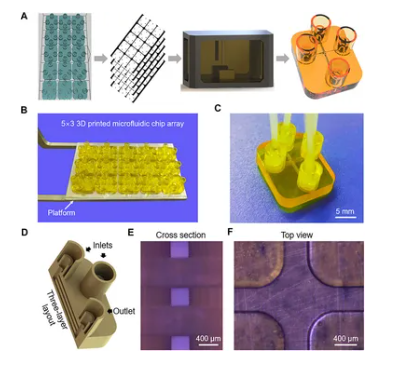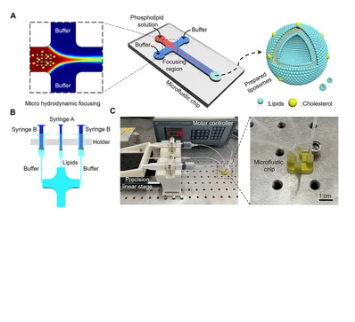文献:3D Printed Integrated Multi-Layer Microfluidic Chips for Ultra-High Volumetric Throughput Nanoliposome Preparation
文献链接:
https://www.frontiersin.org/journals/bioengineering-and-biotechnology/articles/10.3389/fbioe.2021.773705/full
作者:Han Shan , Qibo Lin , Danfeng Wang , Xin Sun , Biao Quan , Xiang Chen , Zeyu Chen
相关产品:DPPC(磷脂)
Cholesterol(胆固醇)
原文摘要:
Although microfluidic approaches for liposomes preparation have been developed, fabricating microfluidic devices remains expensive and time-consuming. Also, owing to the traditional layout of microchannels, the volumetric throughput of microfluidics has been greatly limited. Herein an ultra-high volumetric throughput nanoliposome preparation method using 3D printed microfluidic chips is presented. A high-resolution projection micro stereolithography (PμSL) 3D printer is applied to produce microfluidic chips with critical dimensions of 400 µm. The microchannels of the microfluidic chip adopt a three-layer layout, achieving the total flow rate (TFR) up to 474 ml min−1, which is remarkably higher than those in the reported literature. The liposome size can be as small as 80 nm. The state of flows in microchannels and the effect of turbulence on liposome formation are explored. The experimental results demonstrate that the 3D printed integrated microfluidic chip enables ultra-high volumetric throughput nanoliposome preparation and can control size efficiently, which has great potential in targeting drug delivery systems.
DPPC 是二棕榈酰磷脂酰胆碱(Dipalmitoylphosphatidylcholine)的英文缩写。它是一种磷脂,在生物膜结构和功能等诸多方面发挥关键作用。磷脂是一类含有磷酸的脂类,是生物膜的主要成分。DPPC 的化学结构主要由一个甘油骨架、两个棕榈酸(一种饱和脂肪酸)残基和一个胆碱基团通过磷酸酯键相连构成。两个棕榈酸分别连接在甘油骨架的 sn - 1 和 sn - 2 位置,胆碱基团则通过磷酸酯键连接在甘油骨架的 sn - 3 位置。这种结构使得 DPPC 具有亲水性的头部(胆碱和磷酸基团部分)和疏水性的尾部(两个棕榈酸长链部分),是典型的两性分子。
cholesterol 是胆固醇,胆固醇属于类固醇类化合物,其化学结构包含四个碳环(甾体核),一个羟基连接在碳环的第三位碳原子上,并且在第十七位碳原子上有一个含多个碳原子的侧链。它是一种脂溶性分子,这使得它能够与其他脂质相互作用。胆固醇存在于动物组织中。在人体中,它是细胞膜的重要组成成分,约占质膜脂质的 20% - 30%。在神经系统的髓鞘中,胆固醇含量尤其丰富,这有助于神经信号的快速传导。基于DPPC、cholesterol的性能,介绍如下:

图:制备流程示意
合成如下:
利用建模软件建立STL格式的微流控芯片三维模型。用切片软件对给定厚度的3D模型进行切片。高分辨率PμSL 3D打印机;采用一层一层的方法制备微流控芯片。打印完成后,将微流控芯片浸入乙醇中超声波清洗,去除未固化树脂。随后,微流控芯片在紫外线灯下处理,以提高强度和刚度。为保证脂质完全溶解,将DPPC和胆固醇以一定的摩尔质量比溶于IPA中,旋涡溶解。通过调节安装在精密线性平台。脂质体的形成使用3D打印的三层微流控芯片进行,每两个设备都使用特定的FRR,每个芯片上从三次不同的运行中收集脂质体。

图:作用机制示意
结论:
该文献成功制备出一种使用 3D 打印微流控芯片的超高体积通量纳米脂质体。该微流控芯片的微通道采用三层布局,总流速(TFR)高。实验结果表明,3D打印的集成微流控芯片可实现超高体积通量纳米脂质体制备,并能有效控制尺寸,在靶向给药系统方面具有潜力。

 2025-07-25 作者:ws 来源:
2025-07-25 作者:ws 来源:

